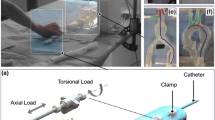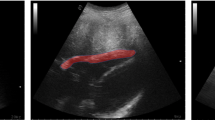Abstract
An accurate assessment of surgical operation skills is essential for improving the vascular intervention surgical outcome and the performance of endovascular surgery robots. In existing studies, subjective and objective assessments of surgical operation skills use a variety of indicators, such as the operation speed and operation smoothness. However, the vascular conditions of particular patients have not been considered in the assessment, leading to deviations in the evaluation. Therefore, in this paper, an operation skills assessment method including the vascular difficulty level index for catheter insertion at the aortic arch in endovascular surgery is proposed. First, the model describing the difficulty of the vascular anatomical structure is established with characteristics of different aortic arch branches based on machine learning. Afterwards, the vascular difficulty level is set as an objective index combined with operating characteristics extracted from the operations performed by surgeons to evaluate the surgical operation skills at the aortic arch using machine learning. The accuracy of the assessment improves from 86.67 to 96.67% after inclusion of the vascular difficulty as an evaluation indicator to more objectively and accurately evaluate skills. The method described in this paper can be adopted to train novice surgeons in endovascular surgery, and for studies of vascular interventional surgery robots.

Operation skill assessment with vascular difficulty for vascular interventional surgery












Similar content being viewed by others
References
Dankelman J, Dobbelsteen JJVD, Breedveld P (2011) Current technology on minimally invasive surgery and Interventional Techniques. Proceedings of International Conference on Instrumentation Control and Automation, 12-15.
Zhang J, Meng C, Ma Y, Liu B, Zhou F (2011) Catheter localization for vascular interventional robot with conventional single C-arm. Proceedings of the IEEE/ICME International Conference on Complex Medical Engineering, 159-164.
Da L, Zhang D, Wang T (2008) Overview of the vascular interventional robot. Int J Med Robot Comput Assist Surg 4:289–294
Bao X, Guo S, Xiao N, Li Y, Yang C, Shen R, Cui J, Jiang Y, Liu X, Liu K (2018) Operation evaluation in-human of a novel remote-controlled vascular interventional robot. Biomed Microdevices 20:34
Yin X, Guo S, Song Y (2018) Magnetorheological fluids actuated haptic-based teleoperated catheter operating system. Micromachines 9:465
Guo S, Wang Y, Xiao N, Li Y, Jiang Y (2018) Study on real-time force feedback with a master-slave interventional surgical robotic system. Biomed Microdevices 20:37
Guo S, Song Y, Yin X, Zhang L, Tamiya T, Hirata H, Ishihara H (2019) A novel robot-assisted endovascular catheterization system with haptic force feedback. IEEE Trans Robot 35:685–696
Rafiitari H, Liu J, Lee SL, Bicknell C, Yang G (2013) Learning-based modeling of endovascular navigation for collaborative robotic catheterization. Proceedings of International Conference on Medical Image Computing and Computer-Assisted Intervention, 369-377.
Guo J, Jin X, Guo S, Fu Q (2019) A vascular interventional surgical robotic system based on force-visual feedback. IEEE Sens J 19:11081–11089. https://doi.org/10.1109/JSEN.2019.2935002
Guo S, Cai X, Gao B, Yang Q, Zhao Y, Xiao N (2017) Tensor-mass model based real-time simulation of vessel deformation and force feedback for the interventional surgery training system. Proceedings of IEEE International Conference on Mechatronics & Automation; 433-438.
Wang Y, Guo S, Xiao N, Li Y, Jiang Y (2018) Surgeons’ operation skill-based control strategy and preliminary evaluation for a vascular interventional surgical robot. J Med Biol Eng 1-12
Song Y, Guo S, Yin X, Zhang L, Hirata H, Ishihara H, Tamiya T (2018) Performance evaluation of a robot-assisted catheter operating system with haptic feedback. Biomed Microdevices 20:50
Zhao Y, Guo S, Xiao N, Wang Y, Li Y, Jiang Y (2018) Operating force information on-line acquisition of a novel slave manipulator for vascular interventional surgery. Biomed Microdevices 20:33
Mitchell EL, Arora S, Moneta GL, Kret MR, Dargon PT, Landry G, Eidt J, Msc N (2014) A systematic review of assessment of skill acquisition and operative competency in vascular surgical training. J Vasc Surg 59:1440–1455
Peters JH, Fried GM, Swanstrom LL, Soper N, Sillin L, Schirmer B, Hoffman K (2004) Development and validation of a comprehensive program of education and assessment of the basic fundamentals of laparoscopic surgery. Surgery 135:21–27
Berry M, Lystig T, Beard J, Klingestierna H, Reznick R, Lönn L (2007) Porcine transfer study: virtual reality simulator training compared with porcine training in endovascular novices. Cardiovasc Interv Radiol 30:455–461
Bech B, Lönn L, Schroeder TV, Rädera SBEW, Ringsteda C (2010) Capturing the essence of developing endovascular expertise for the construction of a global assessment instrument. Eur J Vasc Endovasc Surg 40:292–302
Condino S, Calabrò EM, Alberti A, Parrini S, Cioni R, Berchiolli RN, Gesi M, Ferrari V, Ferrari M (2014) Simultaneous tracking of catheters and guidewires: comparison to standard fluoroscopic guidance for arterial cannulation. Eur J Vasc Endovasc Surg 47:53–60
Van Herzeele I, Aggarwal R, Choong A, Brightwell R, Vermassen F, Cheshire N (2007) Virtual reality simulation objectively differentiates level of carotid stent experience in experienced interventionalists. J Vasc Surg 46:855–863
Rolls AE, Riga CV, Bicknell CD, Stoyanov DV, Shah CV, Van Herzeele I, Hamady M, Cheshire NJ (2013) A pilot study of video-motion analysis in endovascular surgery: development of real-time discriminatory skill metrics. Eur J Vasc Endovasc Surg 45:509–515
Duran C, Estrada S, O"Malley M, Lumsden A, Bismuth J (2015) Kinematics effectively delineate accomplished users of endovascular robotics with a physical training model. J Vasc Surg 61:535-541.
Estrada S, Duran C, Schulz D, Bismuth J, Byrne MD, O’Malley MK (2016) Smoothness of surgical tool tip motion correlates to skill in endovascular tasks. IEEE T Hum-Mach Syst 46:1–13
Estrada S, O’Malley MK, Duran C, Schulz D, Bismuth J (2014) On the development of objective metrics for surgical skills evaluation based on tool motion. Proceedings of IEEE international conference on systems, man and cybernetics, 3144–3149.
Rafii-Tari H, Payne C. J, Bicknell C, Kwok K, Cheshire N, Riga C, Yang G (2017) Objective assessment of endovascular navigation skills with force sensing. Ann Biomed Eng 45:1315-1327.
Rafii-Tari H, Payne CJ, Liu J, Riga C, Bicknell C (1789-1794) Yang G (2015) Towards automated surgical skill evaluation of endovascular catheterization tasks based on force and motion signatures. Proceedings of IEEE International Conference on Robotics and Automation (ICRA)
Mazomenos EB, Chang PL, Rippel RA, Rolls A, Hawkes DJ, Bichnell C, Desjardins A, Riga C, Stoyanov D (2016) Catheter manipulation analysis for objective performance and technical skills assessment in transcatheter aortic valve implantation. Int J Comput Assist Radiol Surg 11:1121–1131
Tercero C, Kodama H, Shi C, Ooe K, Ikeda S, Fukuda T, Arai F, Negoro M, Kwon G, Najdovski Z (2013) Technical skills measurement based on a cyber-physical system for endovascular surgery simulation. Int J Med Robot Comput Assist Surg 9:E25–E33
Srimathveeravalli G, Kesavadas T, Li X (2010) Design and fabrication of a robotic mechanism for remote steering and positioning of interventional devices. Int J Med Robot Comput Assist Surg 6:160–170
Zhou X, Bian G, Xie X, Hou Z, Li R, Zhou Y (2019) Qualitative and quantitative assessment of technical skills in percutaneous coronary intervention: in vivo porcine studies. IEEE Trans Biomed Eng stage of publication (in press) 67:353–364. https://doi.org/10.1109/TBME.2019.2913431
Rong J, Qi C, Ju Q (2015) Application of hierarchical management of vascular difficulty in collecting blood samples of arteries. Chin Nurs Res 29(20):2547–2549
Feng J, Cao J, Wang F. Zhang W (2014) Vascular assessment monitoring table in application of patients with venous transfusion in neurology department. Medical&Pharmaceutical Journal of Chinese People’s Liberation Army 26(05): 102-104.
Essa E, Makki N, Bittenbender P, Capers Q 4th, George B, Rushing G, Crestanello J, Boudoulas KD, Lilly SM (2016) Vascular assessment for transcatheter aortic valve replacement: intravascular ultrasound compared with computed tomography. J Invasive Cardiol 28(12):E172–E178
Han S, Kim H (2019) On the optimal size of candidate feature set in random forest. Appl Sci 9(5):898
Ashraf I, Hur S, Park Y (2018) MagIO: magnetic field strength based indoor- outdoor detection with a commercial smartphone. micromachines 9:534.
Wolpert DH, Macready WG (1996) An efficient method to estimate bagging’s generalization error. Mach Learn 35:41–55
Martínez-Muñoz G, Suárez A (2010) Out-of-bag estimation of the optimal sample size in bagging. Pattern Recogn 43:143–152
Chih-Chung C, Chih-Jen L (2011) LIBSVM: a library for support vector machines. ACM Trans Intell Syst Technol 60:1–27
Du Y, Stephanus A (2016) A novel classification technique of arteriovenous fistula stenosis evaluation using bilateral PPG analysis. Micromachines 7:147
Funding
This research is partly supported by the National High Tech. Research and Development Program of China (No. 2015AA043202) and National Key Research and Development Program of China (2017YFB1304401).
Author information
Authors and Affiliations
Corresponding author
Ethics declarations
Ethical approval
All applicable international, national, and/or institutional guidelines for the care and use of animals were followed.
Informed consent
Informed consent was obtained from all individual participants included in the study.
Additional information
Publisher’s note
Springer Nature remains neutral with regard to jurisdictional claims in published maps and institutional affiliations.
Electronic supplementary material
ESM 1
(PDF 199 kb)
Rights and permissions
About this article
Cite this article
Guo, S., Cui, J., Zhao, Y. et al. Machine learning–based operation skills assessment with vascular difficulty index for vascular intervention surgery. Med Biol Eng Comput 58, 1707–1721 (2020). https://doi.org/10.1007/s11517-020-02195-9
Received:
Accepted:
Published:
Issue Date:
DOI: https://doi.org/10.1007/s11517-020-02195-9




